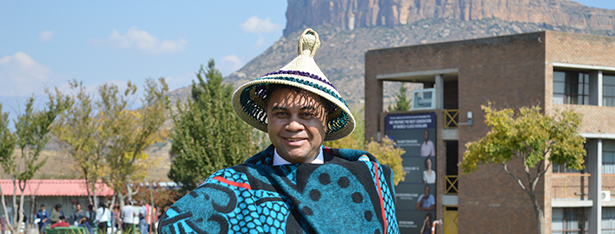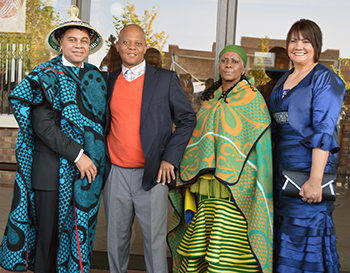
Prof Francis Petersen, Vice-Chancellor and Rector of the University of the Free State
Photo: Ian van Straaten
Photo Gallery
Video
Various stakeholders pledged their support to the newly-appointed Vice-Chancellor and Rector of the University of the Free State (UFS), Prof Francis Petersen, during the first in a series of welcoming events that was held at the Qwaqwa Campus on Thursday 11 May 2017.
A message of support and welcome from the Paramount Queen of the Bakoena Royal Council, Mofumahadi Mathokoana Mopeli, took everybody in attendance back three decades to the time when the campus was first established.
“The Qwaqwa Campus of the then University of the North was created to swell this area and the broader Eastern Free State with intellectual capacity,” she said.
“It is with this in mind that we encourage you, Prof Petersen, to continue upholding the best of your predecessors. Search for what they could not achieve and learn from that. Traditional leadership in this area will always be a friend to the university,” she added.

Prof Petersen received a warm Basotho
welcome from Morena Thokoana Mopeli and
Paramount Queen Mofumahadi Mathokoana Mopeli of
the Bakoena Royal Council. With them is
Mrs Cheslyn Petersen.
Photo: Thabo Kessah
The Thabo Mofutsanyana Education District was represented by the Acting District Director, Lindiwe Mabaso, who expressed the district’s pride in being associated with the university.
“Our district is excelling in Mathematics and Science, and this can be attributed to the educators that we get from the Qwaqwa Campus. We are proud to say that we are number one nationally when it comes to Mathematics and Science, and this is through the support we get from the campus. Our schools will continue to be centres of excellence under the new leadership of Prof Petersen,” she said.
Staff and students weigh in
Both Nehawu and Uvpersu expressed their optimism in working with Prof Petersen.
Branch chairperson of Nehawu, Teboho Pitso, said the union appreciated the fact that Prof Petersen was taking over the leadership of the institution at a very difficult time, both institutionally and nationally.
“As workers, we are faced with a lot of challenges and we hope that none of us will be retrenched under your leadership,” he said to an appreciative audience consisting of various internal and external stakeholders.
Acting Chairperson of UVPERSU, Khethiwe Biyo, said the workers’ union was happy that Prof Petersen believed in teamwork.
“Your commitment in working with us is appreciated. We look forward to learning from you about institutional innovation,” she said.
Students were represented by the Qwaqwa Campus SRC President, Njabulo Mwali, who expressed the need for a deeper and detailed transformation process.
“Your expertise and skills have set you above all other aspirant applicants for this position, and we hope that we will learn a lot on this journey,” he said.
“We at the UFS are actively, intentionally,
and continuously engaged in promoting
diversity.”
"Ensure fairness"
In his response, Prof Petersen emphasised the importance of inclusivity and innovativeness. He said, “Staff and students at the three sites of learning must do all they can to ensure that the UFS realises its goal of being an inclusive institution, one that provides equal access and opportunities to everyone, makes a conscious effort to prevent discrimination, and ensure fairness.”
“Being committed to inclusivity means that we at the UFS are actively, intentionally, and continuously engaged in promoting diversity. This diversity is expressed through our people and through the curriculum, and in the way we work with our communities to promote awareness, empathy, and understanding of the complex ways individuals interact. As you know, our ultimate goal as a university is not only to educate young people up to the point that they graduate. What they learn during their time with us should help shape them into people who can think innovatively in order to address the challenges that face us in the 21st century,” he said.
The Qwaqwa Campus Chorale and the award-winning choir from The Beacon Secondary School in Phuthaditjhaba provided the entertainment.
Similar events will respectively be hosted on the South and Bloemfontein Campuses on 18 and 19 May 2017.